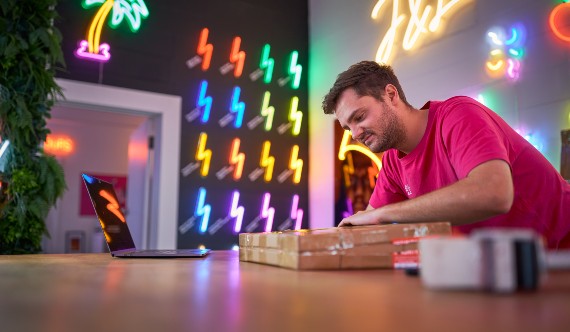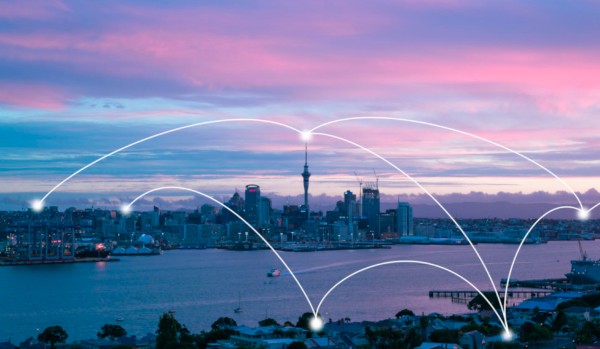5G: Let's talk
IoT is often mentioned in the same breath as 5G.
But what is 5G, exactly? And how does it relate to IoT? And for everyone with a panicky Facebook friend – will it melt your eyeballs or kill your cat?
"No, I’m fairly sure you’re cat's safe," says tech commentator Paul Brislen. "And I think your eyeballs probably as well."
See health information about cell towers and mobile phones
Paul continues, "Health records right throughout the world show that the number of instances of brain tumours, brain cancers and anything that might be associated with cell phone or mobile device use have remained flat for the last hundred years. They haven't gone up, they haven't gone down, they've varied very little. And I think by now we would have seen some evidence if there was anything to be found."
Some alarmists misunderstand that 5G uses the same old radio waves as 4G. What's changing is the way communications across these waves are managed. The "G" in "5G" signifies that it's the fifth generation of mobile data technology.
Benefits of 5G
"The fifth generation of mobile technology brings together three discrete things," explains Spark's lead for Network Evolution, Colin Brown. "One is the ability to supercharge that bandwidth, from megabits to gigabits per second, on your mobile device or on your wireless broadband.
Second, you've got super-low latency – the ability to push the trigger on a button and have the network respond to that in a really fast reaction time. And the third thing that you've got is the ability to bring in millions of devices and massive machine-to-machine type communication. And that's the IoT aspect of 5G.
If you look at the latest Ericsson Mobility Report, for example, mobile phone penetration around the world is now at 104%. So there's more phones than people in the world. So the next real thing is about how do we get things talking to each other and I think that's where the big part of IoT and 5G comes into play."
Existing IoT services are mostly centred on either 4G or the low-power, long-range wireless standard. But where these IoT services fit into 5G depends on the next release of 5G standards, due in 2020. Even then, says Colin, there'll be a "horses for courses" element to it.
"LoRa is very good. It stands for 'long range'. It uses very long battery life and very efficient ways to get spectrum efficiencies and relays to actually get the devices out as far as possible with 4G and IoT. So LoRa will have a place, NB-IoT will have a place, Cat-M1 will have a place, and so will some of the effectively 2G networks that do some of the IoT aspects which some of the other carriers still have in place. So really, it depends on what you need."
Learn about Spark's LoRaWAN™
5G and IoT
"The best case I've got around that is probably the work we're doing with Paymark who introduced EFTPOS machines 30 years ago into New Zealand," says Colin.
"They're experimenting with facial recognition for micropayments. The big barrier for them in the past has been the physical wired infrastructure required to actually stably establish installing the cameras, connecting that back to an AI and a machine to actually make sure it does all the processing.
Then responding to that as fast as possible to recognise the person, the bank account, and allow that transaction to happen in a seamless way. And that's what I mean about the sum of all the parts – it's bandwidth, it's latency, it's masses of machines connected to each other."
For Paul, the low latency of 5G is critical. "[T]hat ability to press a button and have the network computer respond immediately."
As an example, he cites Waze, a navigation app that monitors traffic in real time.
"In the future, for anybody sitting in the car with a 5G-enabled device, the network of users will be able to report back to each other on where the congestion is. That kind of thing is immediately obvious and immediately available. But there are so many other opportunities, it's mind-boggling."
The big showcase for the possibilities of 5G is the 2020 Americas Cup defence next year. Emirates Team New Zealand already deploys around 200 sensors on its racing boat. These sensors generate data that in previous races had to be downloaded to a hard drive and analysed overnight.
But 5G connectivity allows data to be analysed and used to make adjustments in real time. On shore, the demands on bandwidth will ramp up due to the mass of spectators, not to mention the smart rubbish bins asking to be emptied.
The yacht race has also affected Spark's own timeline for 5G deployment. The roadmap for machine-to-machine (M2M) applications will become clearer after the impending release of the next 5G standards.
From then, the availability of devices to meet the network technology will be clearer. Either way, 5G IoT services are probably about a year away.
And even then, Colin emphasises, it's not as if systems using the established network standards will go away.
"It's not necessarily that we're going to roll out 5G and bang, that's the end of anything that we've had before. 5G will be an evolution. It's a natural augmentation for capacity because it has better efficiency, it can carry more data, it gives us more spectrum, but doesn't mean that we then take out the 4G layer on that. We still think there's a long path to the IoT structure around 4G to go yet."




